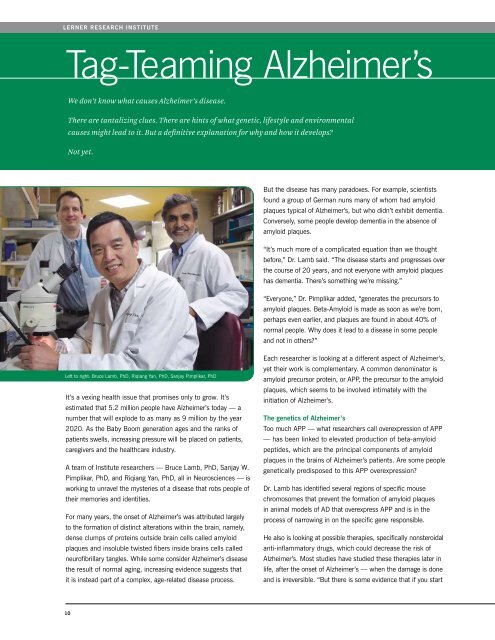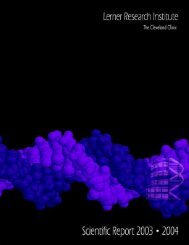<strong>Lerner</strong> research instituteTag-Teaming Alzheimer’sWe don’t know what causes Alzheimer’s disease.There are tantalizing clues. There are hints of what genetic, lifestyle and environmentalcauses might lead to it. But a definitive explanation for why and how it develops?Not yet.But the disease has many paradoxes. For example, scientistsfound a group of German nuns many of whom had amyloidplaques typical of Alzheimer’s, but who didn’t exhibit dementia.Conversely, some people develop dementia in the absence ofamyloid plaques.“It’s much more of a complicated equation than we thoughtbefore,” Dr. Lamb said. “The disease starts and progresses overthe course of 20 years, and not everyone with amyloid plaqueshas dementia. There’s something we’re missing.”“Everyone,” Dr. Pimplikar added, “generates the precursors toamyloid plaques. Beta-Amyloid is made as soon as we’re born,perhaps even earlier, and plaques are found in about 40% ofnormal people. Why does it lead to a disease in some peopleand not in others?”Left to right: Bruce Lamb, PhD, Riqiang Yan, PhD, Sanjay Pimplikar, PhDIt’s a vexing health issue that promises only to grow. It’sestimated that 5.2 million people have Alzheimer’s today — anumber that will explode to as many as 9 million by the year2020. As the Baby Boom generation ages and the ranks ofpatients swells, increasing pressure will be placed on patients,caregivers and the healthcare industry.A team of <strong>Institute</strong> researchers — Bruce Lamb, PhD, Sanjay W.Pimplikar, PhD, and Riqiang Yan, PhD, all in Neurosciences — isworking to unravel the mysteries of a disease that robs people oftheir memories and identities.For many years, the onset of Alzheimer’s was attributed largelyto the formation of distinct alterations within the brain, namely,dense clumps of proteins outside brain cells called amyloidplaques and insoluble twisted fibers inside brains cells calledneurofibrillary tangles. While some consider Alzheimer’s diseasethe result of normal aging, increasing evidence suggests thatit is instead part of a complex, age-related disease process.Each researcher is looking at a different aspect of Alzheimer’s,yet their work is complementary. A common denominator isamyloid precursor protein, or APP, the precursor to the amyloidplaques, which seems to be involved intimately with theinitiation of Alzheimer’s.The genetics of Alzheimer’sToo much APP — what researchers call overexpression of APP— has been linked to elevated production of beta-amyloidpeptides, which are the principal components of amyloidplaques in the brains of Alzheimer’s patients. Are some peoplegenetically predisposed to this APP overexpression?Dr. Lamb has identified several regions of specific mousechromosomes that prevent the formation of amyloid plaquesin animal models of AD that overexpress APP and is in theprocess of narrowing in on the specific gene responsible.He also is looking at possible therapies, specifically nonsteroidalanti-inflammatory drugs, which could decrease the risk ofAlzheimer’s. Most studies have studied these therapies later inlife, after the onset of Alzheimer’s — when the damage is doneand is irreversible. “But there is some evidence that if you start10
Focusing on the patients of tomorrow FALL <strong>2008</strong>In this image, beta-amyloid peptides — which form amyloidplaque in Alzheimer’s patients — are stained red. Microglia(the primary immune cell of the brain) is green, and nuclei arestained blue. The image shows how microglia surround theamyloid plaques. (Photo: Bruce Lamb, PhD, Neurosciences)certain nonsteroidal anti-inflammatories early in life, you candramatically lessen how Alzheimer’s progresses. There’s awindow where it might be effective, but it’s an early window,”Dr. Lamb said.Finally, he is studying what influence diet might play. “We placedseveral different strains of mice on high-fat, high-cholesteroldiets. One strain had an increase in beta-amyloid and severalother strains had no effect. So there might be some geneticpredisposition to dietary effects on beta-amyloid,” he said.The unusual suspectThere are many suspected causes of and contributors toAlzheimer’s. Targeting the right ones is “like shooting in thedark. You know they’re there; you just cannot see them,”said Dr. Pimplikar.Dr. Pimplikar focuses on a relatively new area of Alzheimer’sdealing with APP intracellular domain, or AICD. For years, thegenerally accepted progression of Alzheimer’s went like this:APP is cleaved, or “cut,” by the BACE1 enzyme. One of thepieces is then cleaved again into two still smaller pieces. Onepiece is beta-amyloid, which many consider a cause of thedisease. The second piece is AICD, and it never attractedmuch attention until recently.“We made mice that overexpress only AICD and not betaamyloid,”Dr. Pimplikar said. “And guess what? Our mice startto show lots of symptoms of Alzheimer’s. Why and how is AICDinvolved? Our research seems to indicate that even if you canget rid of beta-amyloid, but still have AICD, you may still getAlzheimer’s. Ultimately, we want to see to what extent AICDcontributes to how Alzheimer’s develops.“Plaques by themselves will induce inflammation, butinflammation starts early or without plaques in our mice.Does AICD play a role in this inflammation process, andcan we develop drugs that are effective against AICD?”Dr. Pimplikar said.Which comes first?The hallmark brain plaque is actually composed of beta-amyloidsurrounded by inflammatory glia (the network of cells thatsupport the nervous system) and abnormal or swollen nerve cellextensions called dystrophic neurites. What hasn’t been knowndefinitively is what role, if any, is played by these dystrophicneurites. Are they a by-product of the formation of beta-amyloid?Could they influence its development? Do they even contributedirectly to the dysfunction associated with Alzheimer’s?Dr. Yan found that increased levels of the protein reticulon 3(RTN3) cause the formation of dystrophic neurites and that havingdystrophic neuritis impairs spatial learning and memory — evenwithout beta-amyloid.“The presence of dystrophic neurites has been identified asone of the distinguishing features in the brains of patients withAlzheimer’s. However, the molecular nature wasn’t understood,until now,” Dr. Yan said.Dr. Yan’s research shows that even a modest increase in RTN3— perhaps only one- or two-fold — is sufficient to cause RTN3aggregation and formation of dystrophic neurites. And whenthese neurites are created, even absent beta-amyloid, cognitiveimpairment still results.“The research suggests that suppressing RTN3 aggregation maynot only delay dysfunction, but also inhibit the BACE1 enzymethat creates the beta-amyloid plaque,” he said. “RTN3 could bea new therapeutic target.”Have we made any progress and is there hope?“There are a lot more unanswered questions, but I believewithin 10 or 15 years we will have therapies that will delay theprogression of Alzheimer’s once it’s started and may even be ableto stop it developing in the first place,” Dr. Pimplikar said. “Justlike President Nixon’s ‘War on Cancer’ led to tremendous resultswithin a decade, we need a similar focus on Alzheimer’s if we’regoing to effectively deal with it.”11
















